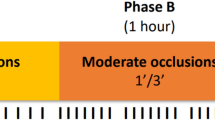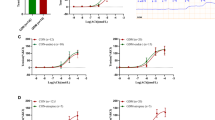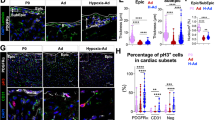Abstract
Hypoxia can lead to adult middle cerebral artery (MCA) dysfunction and increase the risk of cerebrovascular diseases. It is largely unknown whether intrauterine hypoxia affects fetal MCA vasodilatation. This study investigated the effects and mechanisms of intrauterine hypoxia on fetal MCA vasodilatation. Near-term fetal sheep were exposed to intrauterine hypoxia. Human umbilical vein endothelial cells (HUVECs) were exposed to hypoxia in cellular experiments. Vascular tone measurement, molecular analysis, and transmission electron microscope (TEM) were utilized to determine vascular functions, tissue anatomy, and molecular pathways in fetal MCA. In fetal MCA, acetylcholine (ACh) induced reliable relaxation, which was markedly attenuated by intrauterine hypoxia. Atropine, P-F-HHSiD, L-NAME, and u0126 blocked most ACh-mediated dilation, while AF-DX 116 and tropicamide partially inhibited the dilation. Indomethacin and SB203580 did not significantly change ACh-mediated dilation. Tempol and PS-341 could restore the attenuated ACh-mediated vasodilatation following intrauterine hypoxia. The mRNA expression levels of CHRM2 and CHRM3 and the protein levels of CHRM3, p-NOS3, SOD2, ERK1/2, p-ERK1/2, MAPK14, and p-MAPK14 were significantly reduced by intrauterine hypoxia. The dihydroethidium assay showed that the production of ROS was increased under intrauterine hypoxia. TEM analysis revealed endothelial cells damaged by intrauterine hypoxia. In HUVECs, hypoxia increased ROS formation and decreased the expression of CHRM3, p-NOS3, SOD1, SOD2, SOD3, ERK1/2, p-ERK1/2, and p-MAPK14, while tempol and PS-341 potentiated p-NOS3 protein expression. In conclusion, in utero hypoxia reduced ACh-mediated vasodilatation in ovine MCA predominantly via decreased CHRM3 and p-NOS3, and the decreased NOS3 bioactivities might be attributed to ROS and ERK1/2.
This is a preview of subscription content, access via your institution
Access options
Subscribe to this journal
Receive 12 print issues and online access
$259.00 per year
only $21.58 per issue
Buy this article
- Purchase on SpringerLink
- Instant access to full article PDF
Prices may be subject to local taxes which are calculated during checkout






Similar content being viewed by others
References
Ducsay CA, Goyal R, Pearce WJ, Wilson S, Hu XQ, Zhang L. Gestational hypoxia and developmental plasticity. Physiological Rev. 2018;98:1241–334.
Kirkham FJ, Zafeiriou D, Howe D, Czarpran P, Harris A, Gunny R, et al. Fetal stroke and cerebrovascular disease: Advances in understanding from lenticulostriate and venous imaging, alloimmune thrombocytopaenia and monochorionic twins. Eur J Paediatr Neurol. 2018;22:989–1005.
Cananzi SG, Mayhan WG. In utero exposure to alcohol impairs reactivity of cerebral arterioles and increases susceptibility of the brain to damage following ischemia/reperfusion in adulthood. Alcohol Clin Exp Res. 2019;43:607–16.
Ashwal S, Dale PS, Longo LD. Regional cerebral blood flow: Studies in the fetal lamb during hypoxia, hypercapnia, acidosis, and hypotension. Pediatr Res. 1984;18:1309–16.
Thorpe RB, Hubbell MC, Silpanisong J, Williams JM, Pearce WJ. Chronic hypoxia attenuates the vasodilator efficacy of protein kinase g in fetal and adult ovine cerebral arteries. Am J Physiol Heart Circulatory Physiol. 2017;313:H207–H219.
Pearce WJ. Fetal cerebrovascular maturation: effects of hypoxia. Semin Pediatr Neurol. 2018;28:17–28.
Pearce WJ. The fetal cerebral circulation: three decades of exploration by the llu center for perinatal biology. Adv Exp Med Biol. 2014;814:177–91.
Thorpe RB, Hubbell MC, Silpanisong J, Williams JM, Pearce WJ. Chronic hypoxia attenuates the vasodilator efficacy of protein kinase g in fetal and adult ovine cerebral arteries. Am J Physiol Heart Circ Physiol. 2017;313:H207–h219.
Long W, Zhang L, Longo LD. Fetal and adult cerebral artery k(atp) and k(ca) channel responses to long-term hypoxia. J Appl Physiol. 2002;92:1692–701.
Su H, Chen X, Zhang Y, Qi L, He Y, Lv J, et al. In utero hypoxia altered ang ii-induced contraction via pkcβ in fetal cerebral arteries. J Endocrinol. 2020;244:213–22.
Gericke A, Sniatecki JJ, Goloborodko E, Steege A, Zavaritskaya O, Vetter JM, et al. Identification of the muscarinic acetylcholine receptor subtype mediating cholinergic vasodilation in murine retinal arterioles. Investig Ophthalmol Vis Sci. 2011;52:7479–84.
Gonzales RJ, Krause DN, Duckles SP. Testosterone suppresses endothelium-dependent dilation of rat middle cerebral arteries. Am J Physiol Heart Circ Physiol. 2004;286:H552–560.
Gantner BN, LaFond KM, Bonini MG. Nitric oxide in cellular adaptation and disease. Redox Biol. 2020;34:101550.
Tsukahara T, Kassell NF, Hongo K, Vollmer DG, Ogawa H. Muscarinic cholinergic receptors on the endothelium of human cerebral arteries. J Cereb Blood Flow Metab. 1989;9:748–53.
Dauphin F, Hamel E. Muscarinic receptor subtype mediating vasodilation feline middle cerebral artery exhibits m3 pharmacology. Eur J Pharmacol. 1990;178:203–13.
Shimizu T, Rosenblum WI, Nelson GH. M3 and m1 receptors in cerebral arterioles in vivo: Evidence for downregulated or ineffective m1 when endothelium is intact. Am J Physiol. 1993;264:H665–669.
Linville DG, Hamel E. Pharmacological characterization of muscarinic acetylcholine binding sites in human and bovine cerebral microvessels. Naunyn-Schmiedeberg’s Arch Pharmacol. 1995;352:179–86.
Van Charldorp KJ, Davidesko D, Van, Zwieten PA. Selectivity of methoctramine for muscarinic receptors in porcine cerebral arteries. Eur J Pharmacol. 1988;150:197–9.
Dauphin F, Ting V, Payette P, Dennis M, Hamel E. Vasocontractile muscarinic m1 receptors in cat cerebral arteries: Pharmacological identification and detection of mrna. Eur J Pharmacol. 1991;207:319–27.
Yamada M, Basile AS, Fedorova I, Zhang W, Duttaroy A, Cui Y, et al. Novel insights into m5 muscarinic acetylcholine receptor function by the use of gene targeting technology. Life Sci. 2003;74:345–53.
Williams JM, Hull AD, Pearce WJ. Maturational modulation of endothelium-dependent vasodilatation in ovine cerebral arteries. Am J Physiol Regulatory Integr Comp Physiol. 2005;288:R149–157.
White CR, Hamade MW, Siami K, Chang MM, Mangalwadi A, Frangos JA, et al. Maturation enhances fluid shear-induced activation of enos in perfused ovine carotid arteries. Am J Physiol Heart Circulatory Physiol. 2005;289:H2220–2227.
Geary GG, Osol GJ, Longo LD. Development affects in vitro vascular tone and calcium sensitivity in ovine cerebral arteries. J Physiol. 2004;558:883–96.
Förstermann U, Xia N, Li H. Roles of vascular oxidative stress and nitric oxide in the pathogenesis of atherosclerosis. Circulation Res. 2017;120:713–35.
Xiao D, Hu XQ, Huang X, Zhou J, Wilson SM, Yang S, et al. Chronic hypoxia during gestation enhances uterine arterial myogenic tone via heightened oxidative stress. PloS One. 2013;8:e73731.
Zhu X, Gao Q, Tu Q, Zhong Y, Zhu D, Mao C, et al. Prenatal hypoxia enhanced angiotensin ii-mediated vasoconstriction via increased oxidative signaling in fetal rats. Reprod Toxicol. 2016;60:21–28.
Jukic I, Mihaljevic Z, Matic A. Angiotensin ii type 1 receptor is involved in flow-induced vasomotor responses of isolated middle cerebral arteries: Role of oxidative stress. Am J Physiol Heart Circ Physiol. 2021;320:H1609–h1624.
Miller AA, Drummond GR, Schmidt HH, Sobey CG. Nadph oxidase activity and function are profoundly greater in cerebral versus systemic arteries. Circulation Res. 2005;97:1055–62.
Taguchi K, Morishige A, Matsumoto T, Kamata K, Kobayashi T. Enhanced estradiol-induced vasorelaxation in aortas from type 2 diabetic mice may reflect a compensatory role of p38 mapk-mediated enos activation. Pflug Arch: Eur J Physiol. 2012;464:205–15.
Son Y, Cheong YK, Kim NH, Chung HT, Kang DG, Pae HO. Mitogen-activated protein kinases and reactive oxygen species: How can ros activate mapk pathways? J Signal Transduct. 2011;2011:792639.
Sun T, Cao L, Ping NN, Wu Y, Liu DZ, Cao YX. Formononetin upregulates nitric oxide synthase in arterial endothelium through estrogen receptors and mapk pathways. J Pharm Pharmacol. 2016;68:342–51.
Arroyo JA, Anthony RV, Parker TA, Galan HL. Enos, no, and the activation of erk and akt signaling at mid-gestation and near-term in an ovine model of intrauterine growth restriction. Syst Biol Reprod Med. 2010;56:62–73.
Cheriyan J, Webb AJ, Sarov-Blat L, Elkhawad M, Wallace SM, Mäki-Petäjä KM, et al. Inhibition of p38 mitogen-activated protein kinase improves nitric oxide-mediated vasodilatation and reduces inflammation in hypercholesterolemia. Circulation 2011;123:515–23.
Wang B, Xing F, Liu N, Chen D, Li Z, Liu J. P38α subtype is a potential target to inhibit enos activity and no production in human endothelial cells. Microvascular Res. 2014;91:58–65.
Thakor AS, Allison BJ, Niu Y, Botting KJ, Serón-Ferré M, Herrera EA, et al. Melatonin modulates the fetal cardiovascular defense response to acute hypoxia. J pineal Res. 2015;59:80–90.
Pearce W. Hypoxic regulation of the fetal cerebral circulation. J Appl Physiol. 2006;100:731–8.
Brugniaux JV, Hodges AN, Hanly PJ, Poulin MJ. Cerebrovascular responses to altitude. Respiratory Physiol Neurobiol. 2007;158:212–23.
Tsukiyama Y, Iranami H, Kinoshita H, Ogawa K, Hatano Y. Effects of halothane and isoflurane on acetylcholine-induced, endothelium-dependent vasodilation in perfused rat mesenteric arterial beds. J Anesthesia. 2003;17:13–21.
Ambroisine ML, Favre J, Oliviero P, Rodriguez C, Gao J, Thuillez C, et al. Aldosterone-induced coronary dysfunction in transgenic mice involves the calcium-activated potassium (bkca) channels of vascular smooth muscle cells. Circulation. 2007;116:2435–43.
Yu Q, Li K, Zhao A, Wei M, Huang Z, Zhang Y, et al. Sorafenib not only impairs endothelium-dependent relaxation but also promotes vasoconstriction through the upregulation of vasoconstrictive endothelin type b receptors. Toxicol Appl Pharmacol. 2021;414:115420.
Choy WY, Wong YF, Kwan YW, Au AL, Lau WH, Raymond K, et al. Role of mitogen-activated protein kinase pathway in acetylcholine-mediated in vitro relaxation of rat pulmonary artery. Eur J Pharmacol. 2002;434:55–64.
Yeo JL, Tan BT, Achike FI. Exploring the mechanism of endothelial involvement in acidosis-induced vasodilatation of aortic tissues from normal and diabetic rats. Eur J Pharmacol. 2010;642:99–106.
Mukohda M, Mizuno R, Ozaki H. Increased blood pressure causes lymphatic endothelial dysfunction via oxidative stress in spontaneously hypertensive rats. Hypertension. Dallas, Tex.: 1979 2020;76:598–606.
Xu L, Su L, Liu X. Pkcδ regulates death receptor 5 expression induced by ps-341 through atf4-atf3/chop axis in human lung cancer cells. Mol Cancer Ther. 2012;11:2174–82.
Kao C, Chao A, Tsai CL, Chuang WC, Huang WP, Chen GC, et al. Bortezomib enhances cancer cell death by blocking the autophagic flux through stimulating erk phosphorylation. Cell Death Dis. 2014;5:e1510.
Docherty CC, Kalmar-Nagy J, Engelen M, Nathanielsz PW. Development of fetal vascular responses to endothelin-1 and acetylcholine in the sheep. Am J Physiol Regulatory Integr Comp Physiol. 2001;280:R554–562.
Docherty CC, Kalmar-Nagy J, Engelen M, Koenen SV, Nijland M, Kuc RE, et al. Effect of in vivo fetal infusion of dexamethasone at 0.75 ga on fetal ovine resistance artery responses to et-1. Am J Physiol Regulatory Integr Comp Physiol. 2001;281:R261–268.
Inocencio IM, Polglase GR, Miller SL, Sehgal A, Sutherland A, Mihelakis J, et al. Effects of maternal sildenafil treatment on vascular function in growth-restricted fetal sheep. Arteriosclerosis Thrombosis Vasc Biol. 2019;39:731–40.
Hendriks MG, Pfaffendorf M, van Zwieten PA. Characterization of the muscarinic receptors in the mesenteric vascular bed of spontaneously hypertensive rats. J Hypertension. 1993;11:1329–35.
Kwon SC. Mechanisms of acetylcholine-induced vasorelaxation in high k+-stimulated rabbit renal arteries. J Vet Med Sci. 2001;63:41–44.
Hearon CM Jr., Richards JC, Racine ML. Amplification of endothelium-dependent vasodilatation in contracting human skeletal muscle: Role of k(ir) channels. J Physiol. 2019;597:1321–35.
Li T, Luo Z, Liu Y, Wang M, Yu X, Cao C, et al. Excessive activation of nmda receptors induced neurodevelopmental brain damage and cognitive deficits in rats exposed to intrauterine hypoxia. Neurochem Res. 2018;43:566–80.
Brayden JE. Membrane hyperpolarization is a mechanism of endothelium-dependent cerebral vasodilation. Am J Physiol. 1990;259:H668–673.
Farías JG, Herrera EA, Carrasco-Pozo C, Sotomayor-Zárate R, Cruz G, Morales P, et al. Pharmacological models and approaches for pathophysiological conditions associated with hypoxia and oxidative stress. Pharmacol Ther. 2016;158:1–23.
Alonso-Alconada D, Hilario E, Álvarez FJ, Álvarez A. Apoptotic cell death correlates with ros overproduction and early cytokine expression after hypoxia-ischemia in fetal lambs. Reprod Sci. 2012;19:754–63.
Chen X, Qi L, Fan X, Tao H, Zhang M, Gao Q, et al. Prenatal hypoxia affected endothelium-dependent vasodilation in mesenteric arteries of aged offspring via increased oxidative stress. Hypertension Res. 2019;42:863–75.
Acknowledgements
ZX designed the experiments. JT and NL performed surgery and experiments. PZ performed anesthesia. YH and HS performed vascular measurements and molecular tests. YZ (YZ, YZ, YZ) and YY helped with the molecular measurements and cell culture. YH and JT wrote the manuscript, and ZX revised it.
Funding
This work was supported by grants 2019YFA0802601, NSFC (81771592, 82101761), Natural Science Foundation of Jiangsu Province (BK20200194), Suzhou Natural Science Foundation (SYS2019042, KJXW2019006), Wuxi Taihurencai Project Fund, and Postgraduate Research & Practice Innovation Program of Jiangsu Province (KYCX20-2693).
Author information
Authors and Affiliations
Corresponding authors
Ethics declarations
Conflict of interest
The authors declare no competing interests.
Additional information
Publisher’s note Springer Nature remains neutral with regard to jurisdictional claims in published maps and institutional affiliations.
Supplementary information
Rights and permissions
About this article
Cite this article
He, Y., Su, H., Li, N. et al. In utero hypoxia attenuated acetylcholine-mediated vasodilatation via CHRM3/p-NOS3 in fetal sheep MCA: role of ROS/ERK1/2. Hypertens Res 45, 1168–1182 (2022). https://doi.org/10.1038/s41440-022-00935-y
Received:
Revised:
Accepted:
Published:
Issue date:
DOI: https://doi.org/10.1038/s41440-022-00935-y



